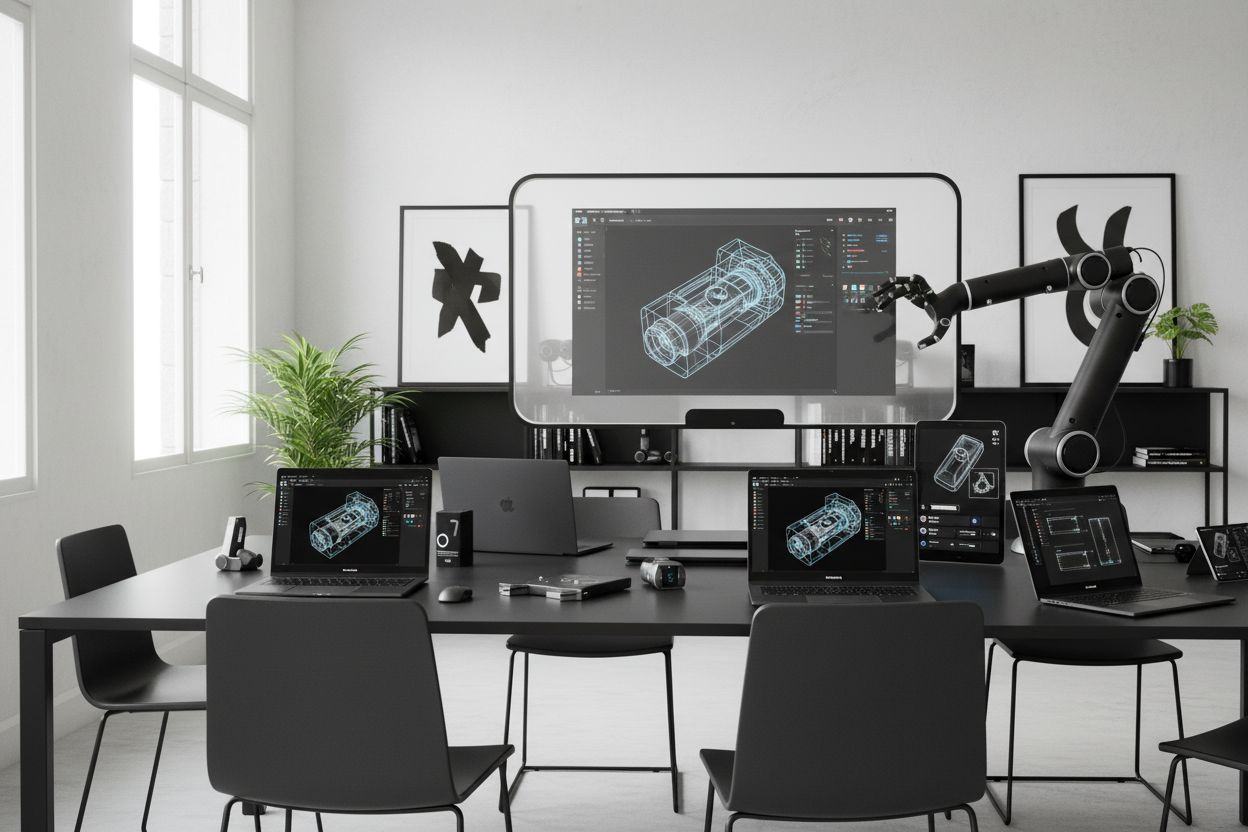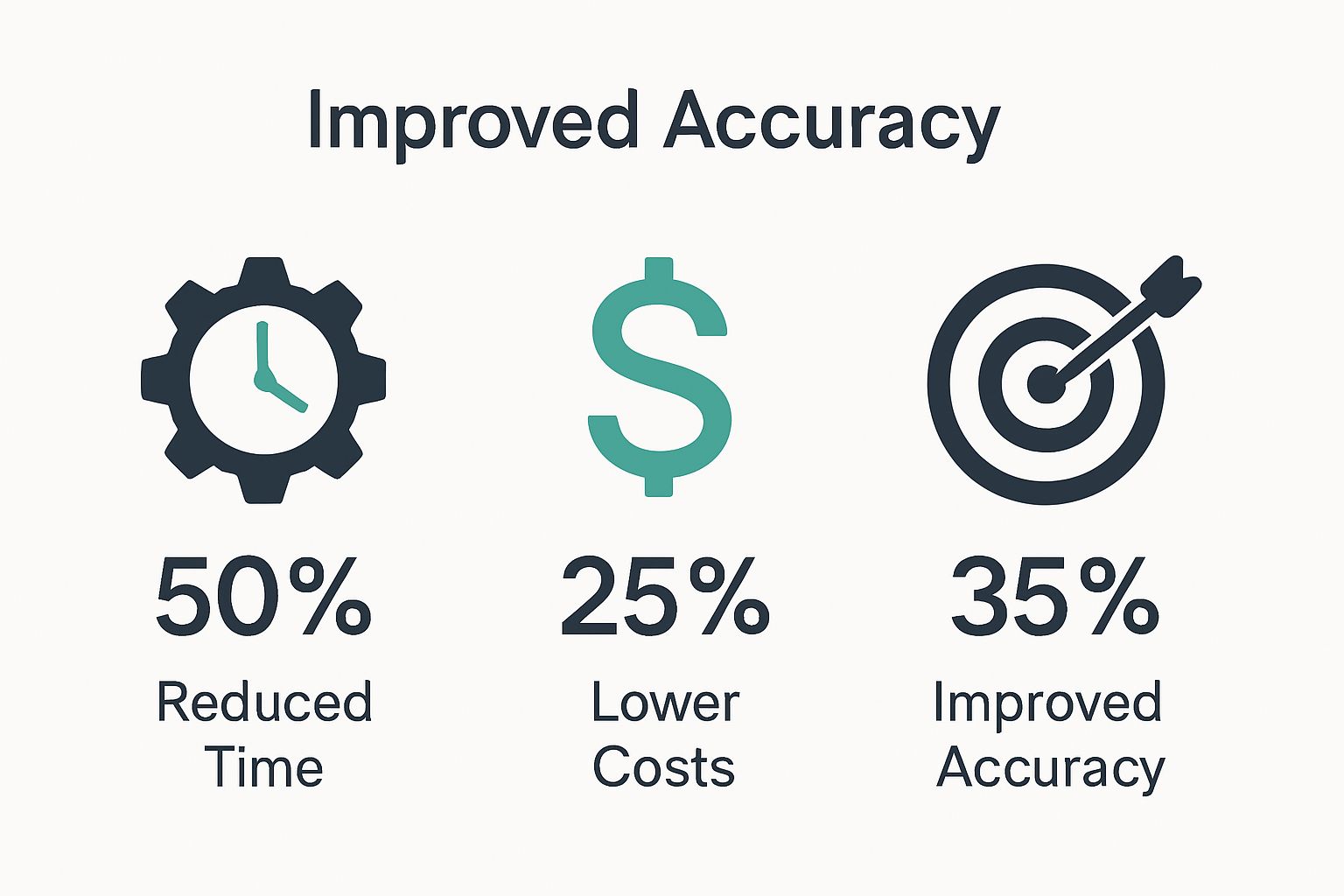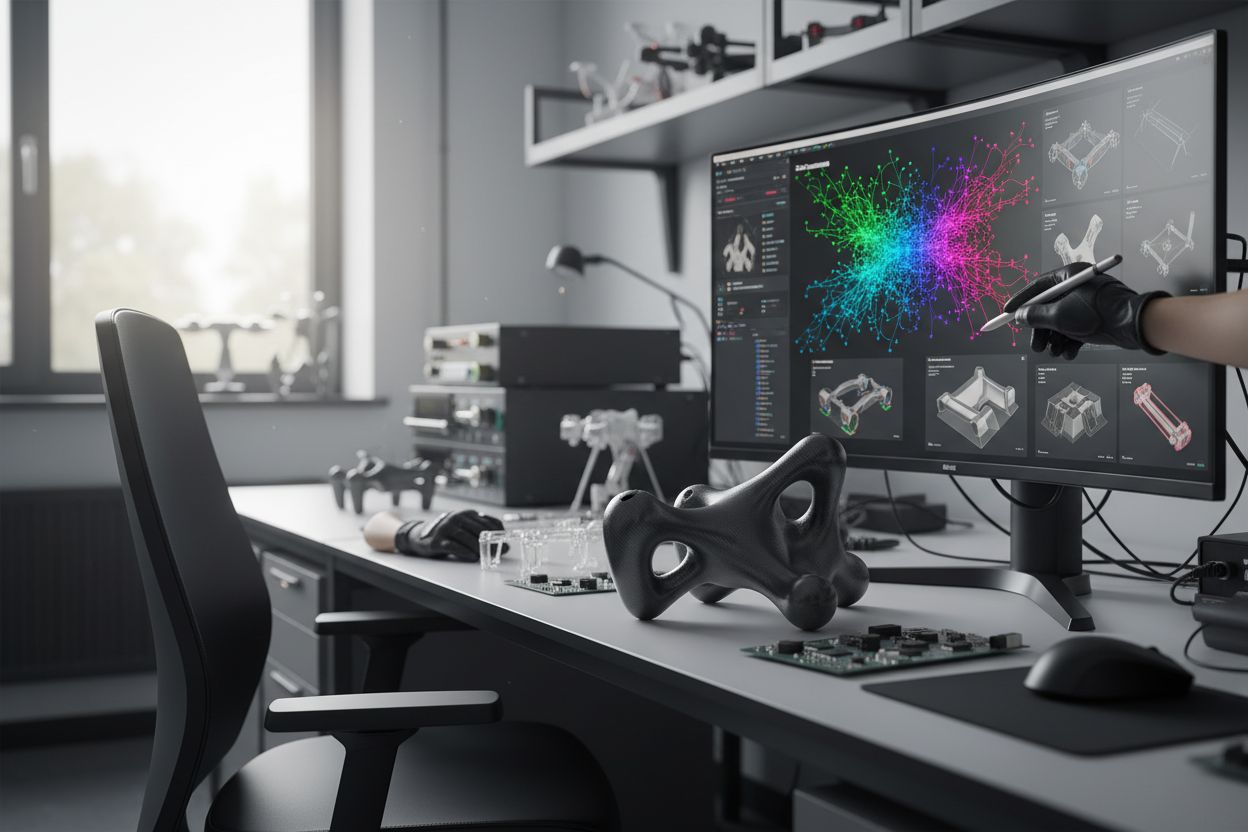Understanding the Role of AI in Product Development

AI is no longer just a buzzword. It is actively reshaping how products are invented, designed, and brought to life. While most people assume AI simply speeds things up or automates basic tasks, that is just scratching the surface. The reality is, companies using AI can slash product development time by up to 50 percent and cut costs by around 25 percent, unlocking possibilities that were out of reach just a few years ago. There is a lot more under the hood than anyone expects.
Table of Contents
- What Is AI And Its Role In Product Development?
- Importance Of AI In Enhancing Product Design And Innovation
- How AI Transforms Customer Insights Into Product Strategy
- Key AI Technologies Shaping Product Development Processes
- Real-World Examples Of AI In Product Development
Quick Summary
| Takeaway | Explanation |
|---|---|
| AI enhances product development efficiency | AI reduces time to market by up to 50%, streamlining design processes and cutting costs by 25%. |
| Predictive analytics optimize design | Utilizing historical data, AI predicts product performance, guiding improvements before physical production begins. |
| AI amplifies human creativity | Rather than replacing creativity, AI supports designers by offering innovative solutions based on data insights. |
| Customer insights drive product strategy | AI analyzes customer behavior to anticipate needs and improve market fit significantly compared to traditional research. |
| Collaborative AI fosters innovation | AI acts as a tool for human teams, enhancing capabilities while keeping strategic decisions in human hands. |
What is AI and Its Role in Product Development?
Artificial Intelligence represents a transformative technology enabling computer systems to perform tasks traditionally requiring human intelligence. In product development, AI serves as a powerful tool that augments human capabilities, helping businesses design, prototype, and refine products more efficiently and strategically. Learn more about AI integration strategies.
Understanding AI in Product Development Context
AI is not a monolithic technology but a sophisticated ecosystem of algorithms, machine learning models, and computational approaches designed to analyze complex data, recognize patterns, and generate intelligent insights. In product development, AI functions as a strategic partner that accelerates innovation by providing data driven recommendations and predictive capabilities.
The role of AI in product development encompasses several critical dimensions:
- Predictive Design Optimization: Using historical data and advanced analytics to anticipate product performance and potential design improvements
- Rapid Prototyping: Generating multiple design iterations quickly and cost effectively
- Risk Assessment: Analyzing potential product failures and performance challenges before physical production
How AI Transforms Product Development Processes
Traditional product development often involves linear, time consuming processes with significant resource investments. AI disrupts this paradigm by introducing intelligent automation and advanced analytical capabilities. Modern AI systems can simulate complex engineering scenarios, predict material behaviors, and recommend design optimizations that human teams might overlook.
The following table compares traditional product development approaches with AI-enhanced processes to highlight the transformative advantages described in the article.
| Approach | Process Characteristics | Time and Cost Impact | Innovation Potential |
|---|---|---|---|
| Traditional Product Development | Linear, manual iterations, resource intensive | Longer cycles, higher costs | Restricted by manual analysis and creativity |
| AI-Driven Product Development | Automated, data-driven, rapid prototyping | Up to 50% faster, 25% cost reduction | Breakthroughs via predictive and collaborative AI |
According to McKinsey Research, companies leveraging AI in product development can reduce time to market by up to 50% and decrease development costs by approximately 25%.

These gains stem from AI’s ability to process vast amounts of data, generate insights rapidly, and support more informed decision making throughout the product lifecycle.
At Average Robot, we emphasize that AI is a collaborative tool. While AI provides powerful computational capabilities, human creativity, strategic thinking, and ethical oversight remain paramount in transforming technological potential into meaningful innovation.
Importance of AI in Enhancing Product Design and Innovation
AI represents a pivotal technological advancement that fundamentally transforms how businesses conceptualize, design, and innovate products. By integrating advanced computational capabilities with strategic human insights, AI enables organizations to transcend traditional design limitations and unlock unprecedented levels of creativity and efficiency. Explore how AI can future proof your business.
Accelerating Design Iteration and Optimization
In the realm of product development, AI serves as a powerful catalyst for innovation by dramatically reducing design cycle times and enhancing the quality of design iterations. Traditional design processes often involve extensive manual iterations, consuming significant time and resources. AI disrupts this paradigm by generating multiple design alternatives simultaneously, analyzing their potential performance, and recommending optimizations based on complex data models.
The strategic advantages of AI in product design include:
- Predictive Performance Modeling: Simulating product behaviors under various conditions before physical prototyping
- Intelligent Design Recommendations: Generating design variations that maximize functional efficiency
- Resource Optimization: Minimizing material waste and reducing development costs
AI Driven Creativity and Problem Solving
Contrary to conventional perceptions, AI does not replace human creativity but substantially amplifies it. Advanced machine learning algorithms can analyze vast datasets, identify subtle patterns, and propose innovative design solutions that human designers might not immediately recognize. According to Harvard Business Review, companies leveraging AI in their design processes report a 40% increase in breakthrough innovation potential.
AI enables businesses to explore design possibilities beyond traditional constraints, transforming complex computational challenges into actionable design insights. By processing multidimensional data and generating nuanced recommendations, AI empowers design teams to push boundaries of what is technically and conceptually possible.
At Average Robot, we believe AI is most powerful when it augments human intelligence. Our approach emphasizes collaborative innovation where technological capabilities are strategically aligned with human creativity, ensuring that AI remains a tool for empowerment rather than replacement.
How AI Transforms Customer Insights into Product Strategy
In the contemporary business ecosystem, AI emerges as a revolutionary tool for translating complex customer data into actionable strategic insights. By leveraging advanced machine learning algorithms and sophisticated data analysis techniques, businesses can now understand customer preferences with unprecedented depth and precision.
Learn more about AI strategic implementation.
Decoding Customer Behavior Through Advanced Analytics
AI transcends traditional market research methodologies by processing massive volumes of unstructured data from diverse sources such as social media, customer interactions, purchasing histories, and digital engagement patterns. These intelligent systems can identify nuanced behavioral trends and emotional signals that human analysts might overlook, providing a holistic view of customer sentiment and potential product expectations.
Key dimensions of AI driven customer insight generation include:
- Predictive Preference Mapping: Anticipating customer needs before explicit demand emerges
- Sentiment Analysis: Interpreting emotional undertones in customer feedback
- Behavioral Pattern Recognition: Understanding underlying motivations behind purchasing decisions
Strategic Product Development Through Intelligent Insights
Customer insights generated through AI are not merely descriptive but profoundly predictive. By analyzing historical data and real time interactions, AI enables businesses to develop products that are precisely calibrated to market expectations. According to Gartner Research, organizations utilizing AI driven customer intelligence report up to 35% more accurate product market fit compared to traditional research methods.
The transformative power of AI lies in its ability to convert raw data into strategic narratives. Machine learning models can segment customer populations with granular precision, identify emerging market trends, and recommend product features that resonate with specific demographic groups. This approach moves beyond demographic stereotypes, focusing on individual preference patterns and contextual understanding.
At Average Robot, we emphasize that AI is a collaborative intelligence tool. While computational capabilities provide profound insights, human strategic interpretation remains crucial in translating these insights into meaningful product development strategies.
Key AI Technologies Shaping Product Development Processes
Artificial Intelligence encompasses a spectrum of sophisticated technologies that are fundamentally reshaping how businesses approach product development. These technological innovations provide unprecedented capabilities for analyzing complex data, generating intelligent insights, and accelerating innovation cycles. Discover adaptive AI technologies for your business.
Machine Learning and Predictive Modeling
Machine learning represents a critical AI technology that enables systems to learn from historical data, identify intricate patterns, and make intelligent predictions without explicit programming. In product development, machine learning algorithms can analyze vast datasets from previous product iterations, customer feedback, and performance metrics to generate nuanced design recommendations and anticipate potential performance challenges.
Key technological capabilities include:
- Generative Design Algorithms: Creating multiple design variations based on defined performance parameters
- Failure Prediction Models: Identifying potential product weaknesses before physical prototype development
- Performance Optimization Techniques: Recommending design modifications to enhance product efficiency
Neural Networks and Complex Problem Solving
Neural networks, inspired by human brain structures, represent another transformative AI technology in product development. These advanced computational models can process multidimensional data simultaneously, recognizing complex relationships that traditional analytical methods might miss. According to MIT Technology Review, companies implementing neural network technologies report up to 45% faster design iteration cycles.
These sophisticated AI systems transcend traditional computational approaches by mimicking cognitive processes.
Below is a summary table of key AI technologies discussed in product development, outlining their core capabilities and impact on the innovation process.
| AI Technology | Description | Key Capabilities |
|---|---|---|
| Machine Learning | Learns from historical data to make predictions | Generative design, failure prediction, performance optimization |
| Predictive Modeling | Uses data trends to forecast outcomes | Anticipates product performance and potential issues |
| Neural Networks | Mimics human brain function to analyze complex data | Simulates engineering scenarios, recognizes intricate patterns |
| Advanced Analytics | Processes and analyzes large amounts of data | Decodes customer behaviors, supports strategic insights |
| Sentiment Analysis | Evaluates emotional signals in text/data | Interprets customer feedback and user sentiment |

At Average Robot, we emphasize that AI technologies are powerful collaboration tools. While these advanced systems provide remarkable computational capabilities, human creativity, strategic thinking, and ethical oversight remain essential in transforming technological potential into meaningful product innovations.
Real-World Examples of AI in Product Development
AI is transforming product development across industries, demonstrating its remarkable potential to drive innovation and solve complex engineering challenges. From automotive manufacturing to consumer electronics, businesses are leveraging intelligent technologies to reimagine how products are conceived, designed, and brought to market. Explore practical AI workflows for business success.
Automotive and Manufacturing Innovations
In the automotive sector, AI has become a game changing technology for product design and development. Companies like Tesla and BMW utilize advanced machine learning algorithms to optimize vehicle performance, predict maintenance requirements, and simulate complex engineering scenarios. These AI systems can generate thousands of design iterations, testing multiple configurations simultaneously to identify the most efficient and safe product designs.
Key AI applications in automotive product development include:
- Autonomous Vehicle Design: Generating safety protocols and performance optimization models
- Materials Science Optimization: Predicting composite material behaviors and performance characteristics
- Manufacturing Process Enhancement: Identifying potential production inefficiencies before physical implementation
Consumer Electronics and Product Personalization
Technology giants like Apple and Google are pioneering AI driven product development strategies that prioritize user experience and personalization. According to Lufthansa Cargo’s AI implementation case study, AI enables businesses to create products that dynamically adapt to user preferences and environmental conditions.
Intelligent product development now involves creating devices that can learn from user interactions, continuously improving their functionality and user experience. Smartphones, smart home devices, and wearable technologies increasingly rely on AI to understand individual user patterns, anticipate needs, and provide personalized experiences that evolve with each interaction.
At Average Robot, we recognize that successful AI implementation is not about replacing human creativity but amplifying it. Our approach emphasizes using AI as a collaborative tool that empowers product development teams to explore innovative solutions while maintaining human oversight and strategic direction.
Transform Customer Insights Into AI-Powered Business Success
Struggling to turn complex data and customer feedback into clear product decisions? If you keep wondering how to bridge the gap between AI theory and real product innovation, you are not alone. This article shows how AI can reshape every phase of product development, but knowing where to begin and how to make it work for your business can feel overwhelming. That is why Average Robot focuses on the critical pain points discussed here including predictive design, data-driven decision making, and aligning new technology with actual business strategy. Our consulting approach is built for leaders who want to drive bottom-line results and empower their entire organization with practical, accountable AI solutions. Explore how AI can future proof your business if you are ready to move from theory to measurable impact.

Ready to leverage the full power of AI and stay ahead of market changes? Visit Average Robot’s main site now. Take your next step toward operational resilience and smarter product development. Connect with experts who speak your language and who make AI work for your real-world goals.
Frequently Asked Questions
What is the role of AI in product development?
AI enhances product development by automating tasks and providing data-driven insights that help teams create and refine products more efficiently. To leverage AI in your processes, consider integrating predictive analytics and rapid prototyping tools to accelerate your design cycles.
How can AI improve design optimization?
AI improves design optimization by analyzing historical data to recommend enhancements and predict product performance under various conditions. Implement machine learning algorithms to simulate different design scenarios, enabling a reduction in design iteration times by up to 50%.
What are the benefits of using AI for customer insights in product development?
AI enables businesses to decode customer behavior and preferences through advanced analytics, resulting in products that closely align with market demands. Start by using AI tools to collect and analyze customer feedback, which can enhance your product market fit by approximately 35%.
How does AI-driven rapid prototyping work?
AI-driven rapid prototyping generates multiple design iterations simultaneously, allowing businesses to test various concepts quickly and at a lower cost. Adopt AI-based design automation tools to enhance your prototyping efficiency, which can significantly decrease development timelines.
Can AI replace human creativity in product development?
No, AI is designed to complement rather than replace human creativity. Utilize AI to enhance your design processes, ensuring that human insights and innovative thinking remain central to your product development strategy.
What types of AI technologies are most effective for product development?
Key AI technologies include machine learning for predictive modeling and neural networks for complex problem-solving, which can analyze data and generate insights more efficiently. Explore implementing these technologies in your product development workflows to streamline processes and enhance innovation.




